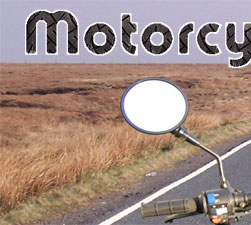|

|
Steering a motorcycle is fundamentally different from four wheeled vehicles. In a car or truck, the direction the front wheels point dictates where the car goes. Getting a motorcycle to turn is all about the lean. If you lean a bike to the right, it will turn right. If you lean to the left, it will turn left. The easiest way to initiate and control a lean is by maneuvering the handlebars. How to do that properly is not entirely intuitive. To get a motorcycle to turn right, you push forward on the right handgrip. Though this causes the front fork to turn to the left, the motorcycle itself will lean right and turn in that direction. This effect is called countersteering. Countersteering is the ONLY way to effectively control a motorcycle's lean at any speed over about 5 mph. At speed, the rotational force of the spinning wheels has a gyroscopic effect keeping the motorcycle balanced and upright. These forces also cause the two wheels to try to stay in line with each other at all times. If you push the right handgrip forward and the front wheel will turn toward the left but the motorcycle will lean right in an effort to keep the wheels in line. Eventually, it will become natural but keep in mind that it only takes a small change in handlebar position to cause the motorcycle to lean enough to turn.

When approaching a turn it
is important to slow the motorcycle and downshift accordingly
BEFORE entering the turn. Make sure to turn your head in
the direction you want the bike to go. Looking through the
turn will help keep a smooth path of travel, control the
lean and keep you aware of any potential obstacles. Press
forward on the handgrip in the direction you want to turn
to initiate the lean. It is important not to slow down during
the turn. Decelerating too much while leaning will reduce
the rotational force of the wheels that keep the motorcycle
upright through the turn. It is important to keep a constant
speed or slightly increase speed to keep the motorcycle
stable. Accelerating excessively while turning can reduce
the rear wheel's traction, which can reduce stability as
well. Unless the turn is very slow and tight, the rider
should lean with the motorcycle. In slow, tight turns it
is possible to use a counterweight technique to better balance
the bike. To counterweight a turn you should still look
in the direction of the turn but will lean your upper body
toward the outside of the turn. This should only be done
at very low speeds when countersteering is less necessary
and a rider can steer the motorcycle by turning the handlebars
more in the direction of the turn.
Once on the road, it is critical to always communicate
your intentions to the motorists around you. You can use
your motorcycle's turn signals, flash your brake light,
and manage your lane position to let help other drivers
anticipate your movements. Your motorcycle's horn can even
be used sparingly to get the attention of any distracted
drivers around you. Also, remember to use your mirrors and
check your blind spot before making any lane changes.
|






